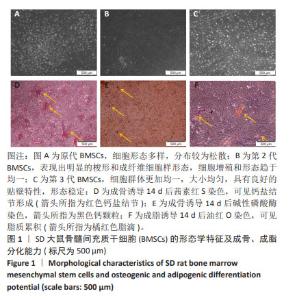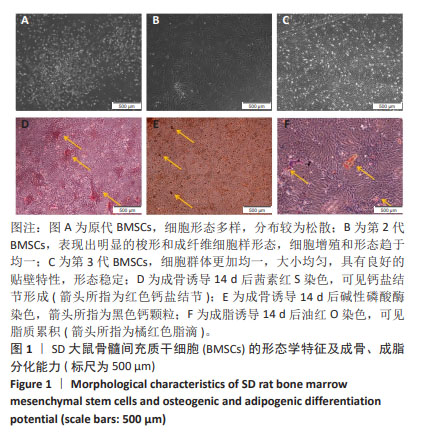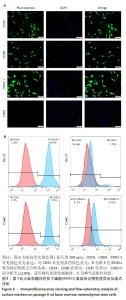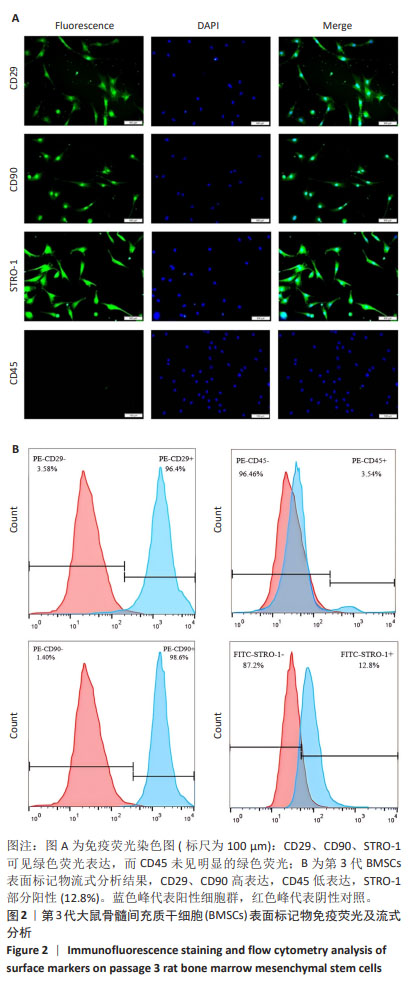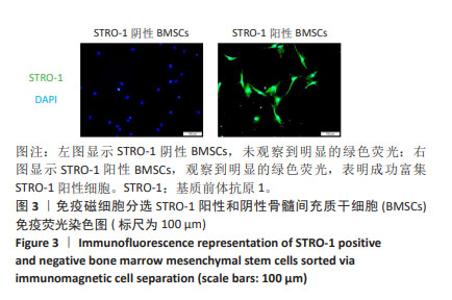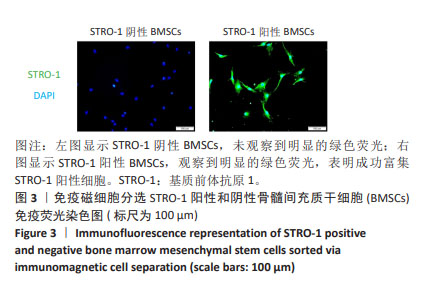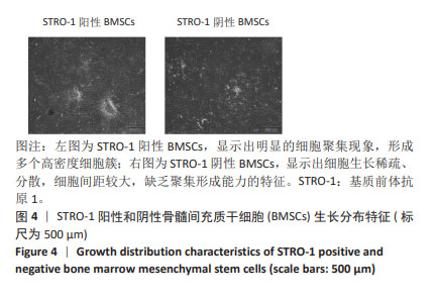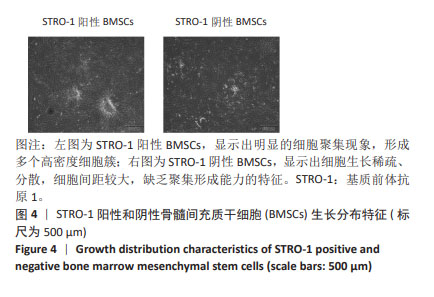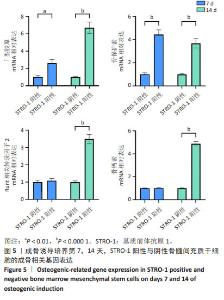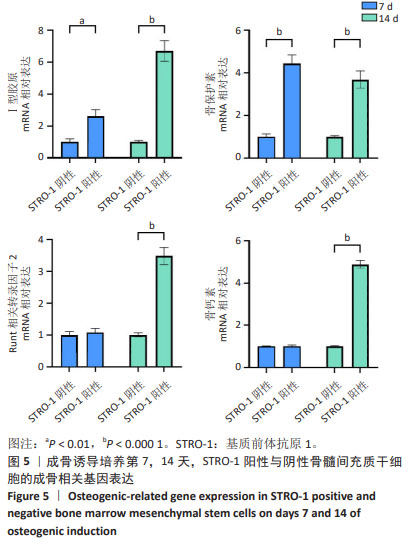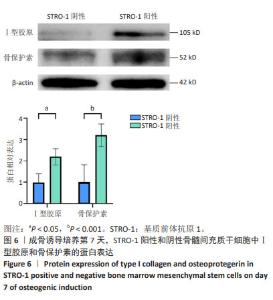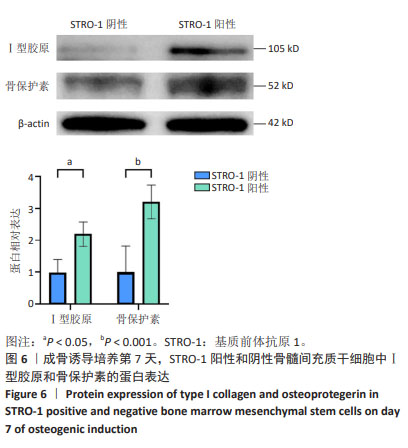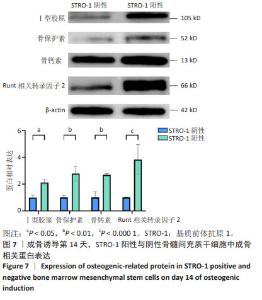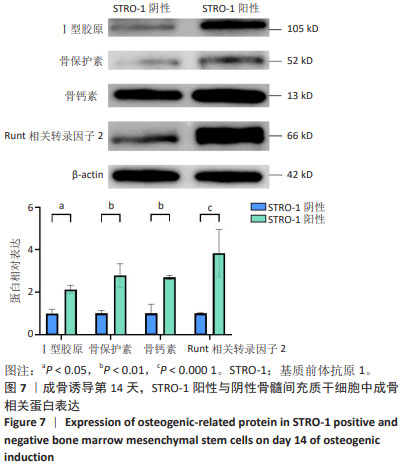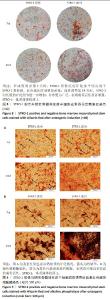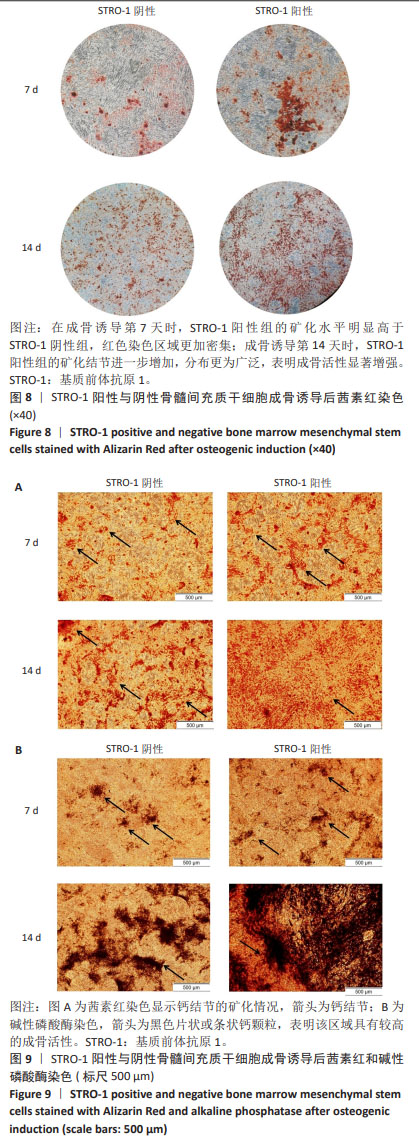Chinese Journal of Tissue Engineering Research ›› 2025, Vol. 29 ›› Issue (36): 7719-7727.doi: 10.12307/2025.564
Previous Articles Next Articles
Comparison of osteogenic potential in STRO-1 positive and negative bone marrow mesenchymal stem cells
Zhou Wanlin1, He Bin2, Shen Xiongcheng1, Huang Kun1, Tian Renyuan1, Yuan Ye1, Huang Wenliang3
- 1Department of Orthopedics, Third Affiliated Hospital of Zunyi Medical University (First People’s Hospital of Zunyi City), Zunyi 563000, Guizhou Province, China; 2Department of Orthopedics, Honghuagang District People’s Hospital of Zunyi City, Zunyi 563000, Guizhou Province, China; 3Department of Orthopedics, Moutai Hospital of Guizhou Province, Renhuai 564500, Guizhou Province, China
-
Received:2024-09-23Accepted:2024-11-14Online:2025-12-28Published:2025-03-03 -
Contact:Huang Wenliang, MS, Chief physician, Department of Orthopedics, Moutai Hospital of Guizhou Province, Renhuai 564500, Guizhou Province, China -
About author:Zhou Wanlin, Master candidate, Physician, Department of Orthopedics, Third Affiliated Hospital of Zunyi Medical University (First People’s Hospital of Zunyi City), Zunyi 563000, Guizhou Province, China -
Supported by:Guizhou Provincial Science and Technology Plan Project, No. ZK[2021]387 (to HWL); Guizhou Provincial Science and Technology Plan Project, No. LC[2024]019 (to HWL); Guizhou Provincial Health Commission Science and Technology Fund Project, No. gzwjk2024-410 (to SXC); Guizhou Provincial Health Commission Science and Technology Fund Project, No. gzwjk2020-1-131 (to HB)
CLC Number:
Cite this article
Zhou Wanlin, He Bin, Shen Xiongcheng, Huang Kun, Tian Renyuan, Yuan Ye, Huang Wenliang. Comparison of osteogenic potential in STRO-1 positive and negative bone marrow mesenchymal stem cells[J]. Chinese Journal of Tissue Engineering Research, 2025, 29(36): 7719-7727.
share this article
Add to citation manager EndNote|Reference Manager|ProCite|BibTeX|RefWorks
| [1] WATSON E, MIKOS AG. Advances in In Vitro and In Vivo Bioreactor-Based Bone Generation for Craniofacial Tissue Engineering. BME Front. 2023;31(4):0004. [2] TOOSI S, NADERI-MESHKIN H, MORADI A, et al. Scaphoid Bone Nonunions: Clinical and Functional Outcomes of Collagen/PGA Scaffolds and Cell-Based Therapy. ACS Biomater Sci Eng. 2023;9(4):1928-1939. [3] APATZIDOU DA, ILIOPOULOS JM, KONSTANTINIDIS A, et al. Inflammatory and bone remodelling related biomarkers following periodontal transplantation of the tissue engineered biocomplex. Clin Oral Investig. 2024;28(7):361. [4] SEEBACH C, NAU C, HENRICH D, et al. Cell-Based Therapy by Autologous Bone Marrow-Derived Mononuclear Cells for Bone Augmentation of Plate-Stabilized Proximal Humeral Fractures: A Multicentric, Randomized, Open Phase IIa study. Stem Cells Transl Med. 2024;13(1):3-13. [5] LIU HC, LIU TT, LIU YL, et al. Atelocollagen-Embedded Chondrocyte Precursors as a Treatment for Grade-4 Cartilage Defects of the Femoral Condyle: A Case Series with up to 9-Year Follow-Up. Biomolecules. 2021;11(7):942. [6] WANG J, WANG T, ZHANG F, et al. Roles of circular RNAs in osteogenic differentiation of bone marrow mesenchymal stem cells (Review). Mol Med Rep. 2022;26(1):227. [7] COUTO DE CARVALHO LA, TOSTA DOS SANTOS SL, SACRAMENTO LV, et al. Mesenchymal stem cell markers in periodontal tissues and periapical lesions. Acta Histochem. 2020;122(8):151636. [8] ONOKI T, KANCZLER J, RAWLINGS A, et al. Modulation of osteoblastogenesis by NRF2: NRF2 activation suppresses osteogenic differentiation and enhances mineralization in human bone marrow-derived mesenchymal stromal cells. FASEB J. 2024;38(17):e23892. [9] BROWN S, MATTA A, ERWIN M, et al. Cell Clusters Are Indicative of Stem Cell Activity in the Degenerate Intervertebral Disc: Can Their Properties Be Manipulated to Improve Intrinsic Repair of the Disc? Stem Cells Dev. 2018;27(3):147-165. [10] PAGANELLI A, TRUBIANI O, DIOMEDE F, et al. Immunomodulating Profile of Dental Mesenchymal Stromal Cells: A Comprehensive Overview. Front Oral Health. 2021;2:635055. [11] SUNDIN A, IONESCU SI, BALKAN W, et al. Mesenchymal STRO-1/STRO-3+ precursor cells for the treatment of chronic heart failure with reduced ejection fraction. Future Cardiol. 2023;19(12):567-581. [12] STAMNITZ S, KRAWCZENKO A, SZAŁAJ U, et al. Osteogenic Potential of Sheep Mesenchymal Stem Cells Preconditioned with BMP-2 and FGF-2 and Seeded on an nHAP-Coated PCL/HAP/β-TCP Scaffold. Cells. 2022;11(21):3446. [13] YANG K, LUAN YY, WANG S, et al. SGMS1 facilitates osteogenic differentiation of MSCs and strengthens osteogenesis-angiogenesis coupling by modulating Cer/PP2A/Akt pathway. iScience. 2024;27(4): 109358. [14] LUO P, ZHANG Y, HUANG M, et al. Microdroplets Encapsulated with NFATc1-siRNA and Exosomes-Derived from MSCs Onto 3D Porous PLA Scaffold for Regulating Osteoclastogenesis and Promoting Osteogenesis. Int J Nanomedicine. 2024;19:3423-3440. [15] CAO Y, BOLAM SM, BOSS AL, et al. Characterization of adult human skeletal cells in different tissues reveals a CD90+CD34+ periosteal stem/progenitor population. Bone. 2024;178:116926. [16] ZHAO J, LI X, HU J, et al. Mesenchymal stromal cell-derived exosomes attenuate myocardial ischaemia-reperfusion injury through miR-182-regulated macrophage polarization. Cardiovasc Res. 2019;115(7): 1205-1216. [17] BAI Z, HU K, SHOU Z, et al. Engineering a mucin coating to promote osteogenic differentiation of BMSCs in vitro and bone formation in vivo through the Wnt/β-catenin pathway. Colloids Surf B Biointerfaces. 2023;221:113000. [18] ZHAO XE, YANG Z, GAO Z, et al. 6-Bromoindirubin-3’-oxime promotes osteogenic differentiation of canine BMSCs through inhibition of GSK3β activity and activation of the Wnt/β-catenin signaling pathway. An Acad Bras Cienc. 2019;91(1):e20180459. [19] RUNGSIWIWUT R, NUMCHAISRIKA P, THUWANUT P, et al. Characterization of stem cells from human ovarian follicular fluid; a potential source of autologous stem cell for cell-based therapy. Hum Cell. 2021;34(2):300-309. [20] SAADH MJ, RAMÍREZ-CORONEL AA, SAINI RS, et al. Advances in mesenchymal stem/stromal cell-based therapy and their extracellular vesicles for skin wound healing. Hum Cell. 2023;36(4):1253-1264. [21] HUANG F, GAO T, FENG Y, et al. Bioinspired Collagen Scaffold Loaded with bFGF-Overexpressing Human Mesenchymal Stromal Cells Accelerating Diabetic Skin Wound Healing via HIF-1 Signal Pathway Regulated Neovascularization. ACS Appl Mater Interfaces. 2024;16(35):45989-46004. [22] KERSTAN A, DIETER K, NIEBERGALL-ROTH E, et al. Translational development of ABCB5+ dermal mesenchymal stem cells for therapeutic induction of angiogenesis in non-healing diabetic foot ulcers. Stem Cell Res Ther. 2022;13(1):455. [23] LU X, SUN S, LI N, et al. Janus sponge/electrospun fibre composite combined with EGF/bFGF/CHX promotes reconstruction in oral tissue regeneration. Colloids Surf B Biointerfaces. 2024;243:114117. [24] 张文荟,裴晓杭,孔黛,等.脐带间充质干细胞替代供者骨髓细胞在单倍体相合造血干细胞移植中的作用[J].中国组织工程研究, 2024,28(13):2042-2046. [25] 李石旦,邢伟,谢晓瑜,等.提取人骨髓间充质干细胞的新方法与传统方法比较[J].中国组织工程研究,2022,26(24):3814-3820. [26] TAN C, TAN S, ZHANG H, et al. Enhanced migration and immunoregulatory capacity of BMSCs mediated by overexpression of CXCR4 and IL-35. Mol Immunol. 2022;150:1-8. [27] WANG K, ZHU H, YANG L, et al. miR-139 promotes homing of bone marrow mesenchymal stem cells (BMSCs) to lung tissues of asthmatic rats to inhibit inflammatory response of Th2 cells by down-regulating Notch1/Hes1 pathway. Xi Bao Yu Fen Zi Mian Yi Xue Za Zhi. 2021;37(2):97-104. [28] SONG Y, WU H, GAO Y, et al. Zinc Silicate/Nano-Hydroxyapatite/Collagen Scaffolds Promote Angiogenesis and Bone Regeneration via the p38 MAPK Pathway in Activated Monocytes. ACS Appl Mater Interfaces. 2020;12(14):16058-16075. [29] MA TX, XU YW, JIANG DY. Effects and mechanism of interleukin-17-modified mouse bone marrow mesenchymal stem cells on rejection reaction of allogeneic skin transplantation in mice. Zhonghua Shao Shang Za Zhi. 2020;36(3):234-243. [30] SANZ-SÁNCHEZ I, SANZ-MARTÍN I, ORTIZ-VIGÓN A, et al. Complications in bone-grafting procedures: Classification and management. Periodontol 2000. 2022;88(1):86-102. [31] SCHMIDT AH. Autologous bone graft: Is it still the gold standard? Injury. 2021;52 Suppl 2:S18-S22. [32] MATTHEWS JR, BRUTICO JM, ABRAHAM DT, et al. Differences in Clinical and Functional Outcomes Between Osteochondral Allograft Transplantation and Autologous Chondrocyte Implantation for the Treatment of Focal Articular Cartilage Defects. Orthop J Sports Med. 2022;10(2):23259671211058425. [33] ORYAN A, ALIDADI S, MOSHIRI A, et al. Bone regenerative medicine: classic options, novel strategies, and future directions. J Orthop Surg Res. 2014;9(1):18. [34] DOMINICI M, LE BLANC K, MUELLER I, et al. Minimal criteria for defining multipotent mesenchymal stromal cells. The International Society for Cellular Therapy position statement. Cytotherapy. 2006;8(4):315-317. [35] CHOPRA H, LIAO C, ZHANG CF, et al. Lapine periodontal ligament stem cells for musculoskeletal research in preclinical animal trials. J Transl Med. 2018;16(1):174. [36] PENG Q, DUDA M, REN G, et al. Multiplex Analysis of Adipose-Derived Stem Cell (ASC) Immunophenotype Adaption to In Vitro Expansion. Cells. 2021;10(2):218. [37] SABBAGH J, GHASSIBE-SABBAGH M, FAYYAD-KAZAN M, et al. Differences in osteogenic and odontogenic differentiation potential of DPSCs and SHED. J Dent. 2020;101:103413. [38] KOMORI T. Whole Aspect of Runx2 Functions in Skeletal Development. Int J Mol Sci. 2022;23(10):5776. [39] LI C, QIAN YH. Inflammation-dependent activation of NCOA2 associates with p300 and c-MYC/Max heterodimer to transactivate RUNX2-AS1 and mediate RUNX2 downstream bone differentiation genes in the pathology of septic nonunion. Cytokine. 2022;158:155992. [40] DONSANTE S, PALMISANO B, SERAFINI M, et al. From Stem Cells to Bone-Forming Cells. Int J Mol Sci. 2021;22(8):3989. [41] XUE F, ZHAO Z, GU Y, et al. 7,8-Dihydroxyflavone modulates bone formation and resorption and ameliorates ovariectomy-induced osteoporosis. Elife. 2021;10:e64872. [42] MA X, MENG J, JIA M, et al. Exendin-4, a glucagon-like peptide-1 receptor agonist, prevents osteopenia by promoting bone formation and suppressing bone resorption in aged ovariectomized rats. J Bone Miner Res. 2013;28(7):1641-1652. [43] LIU H, HAN X, YANG H, et al. GREM1 inhibits osteogenic differentiation, senescence and BMP transcription of adipose-derived stem cells. Connect Tissue Res. 2021;62(3):325-336. |
| [1] | Sun Zheng, Zhao Hua. Mechanism of erythropoietin/erythropoietin receptor signaling pathway in regulating osteogenic differentiation of periodontal ligament stem cells [J]. Chinese Journal of Tissue Engineering Research, 2025, 29(36): 7762-7768. |
| [2] | Kong Ning, Tang Jixiang, Hou Yubo, Meng Lan, Sun Lei, Ma Baodong, Shao Yiming, Jin Ranran, Yue Han, Zhang Hui. Effects of human umbilical cord mesenchymal stem cells overexpressing erythropoietin on apoptosis of SH-SY5Y neurons in ischemia and hypoxia [J]. Chinese Journal of Tissue Engineering Research, 2025, 29(36): 7752-7761. |
| [3] | Wu Yue, Zhu Yongna, Ge Xiang, Liu Fan, He Zeyu, Liu Xi. Nuclear factor I-C regulates differentiation of human stem cells from apical papilla [J]. Chinese Journal of Tissue Engineering Research, 2025, 29(31): 6667-6673. |
| [4] | Sun Tianjing , Liu Sijia , Xie Fangke , Huang Xiaofei , Zhang Ji , Jiang Xuheng , Feng Hua, Yu Anyong. Role and hotspots of stem cell-derived exosome in the repair of traumatic brain injury [J]. Chinese Journal of Tissue Engineering Research, 2021, 25(1): 123-127. |
| [5] | Bi Lian-yong. Neuroprotective effects of salvianolic acid B against Schwann cell injury induced by lipopolysaccharide [J]. Chinese Journal of Tissue Engineering Research, 2015, 19(42): 6813-6818. |
| [6] | Bai Dong, Zhou Zhong-xiao, Zhang Jian. Hepatocyte proliferation and apoptosis under regulation of human telomerase reverse transcriptase gene-modified bone marrow mesenchymal stem cells [J]. Chinese Journal of Tissue Engineering Research, 2015, 19(32): 5118-5122. |
| [7] | He Ze-bin, Zhao Yun-he, Yang Gui-jiao, Lu Li. Effect of p53 inhibitor on viability of human bone marrow mesenchymal stem cells in late-phase amplification [J]. Chinese Journal of Tissue Engineering Research, 2015, 19(23): 3616-3620. |
| [8] | Shao Shuai, Zhou Chen-hong, Xu Li-li. Differentiation of bone marrow and umbilical cord blood mesenchymal stem cells into osteoblasts in vitro: comparison of their osteogenic potentials [J]. Chinese Journal of Tissue Engineering Research, 2015, 19(23): 3652-3657. |
| [9] | Tan Yu-lin1, Bao Tong-zhu, Liu Qin, Han Yu, Wang Yan-lin, Liu Yang, Zhou Na-xin, Yan Fei,Zhao Long-tao. Influence of geniposide on collagen II synthesis of cultured chondrocytes in vitro [J]. Chinese Journal of Tissue Engineering Research, 2014, 18(20): 3149-3152. |
| [10] | Qu Shao-zheng, Li Shu-zhong, Gao Jia-ke, Zhang Jin-feng. Isolation and identification of osteosarcoma stem cells [J]. Chinese Journal of Tissue Engineering Research, 2013, 17(14): 2641-2648. |
| [11] | Zhao Zhen-de. Artificial bone combined with bone marrow mesenchymal stem cells for repairing femoral head necrosis in rabbits [J]. Chinese Journal of Tissue Engineering Research, 2012, 16(38): 7057-7062. |
| [12] | Yang Wen, Qin Shan-yu, Jiang Hai-xing, Zhang Jun-hong, Ning Lin, Meng Yun-chao. 骨髓间充质干细胞体外调控肝星状细胞死亡受体5的表达 [J]. Chinese Journal of Tissue Engineering Research, 2012, 16(27): 4947-4952. |
| Viewed | ||||||
|
Full text |
|
|||||
|
Abstract |
|
|||||
